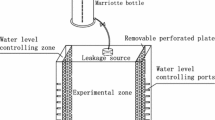Abstract
A model is presented for the description of the pump and treat (or flushing) remediation of the saturated zone with non-aqueous phase liquid (NAPL) present as droplets. Sensitivity analysis shows that the most important variables are the NAPL droplet size and the distance through which the dissolved organic compound must diffuse to reach the advecting aqueous phase. The time needed to achieve complete remediation for different initial contaminant concentrations in soil depends more on the NAPL droplet radius and the size of the stagnant boundary layer than on the initial contaminant mass itself. Location of wells and flux rates are of little significance over the time needed for completion as long as all the water that flows through the contaminated region is captured in the recovery well.
Similar content being viewed by others
References
Bibby, R.: 1981, ‘Mass Transport of Solutes in Dual-Porosity Media’, Water Resources Research 17, 1075.
Feenstra, S. and Cherry, J.A.: 1987, ‘Dense Organic Solvents in Ground Water’, Institute for Ground Water Research, University of Waterloo, Waterloo, Ont., Progress Report No. 0863985.
Gomez-Lahoz, C., Rodríguez-Maroto, J.M. and Wilson, D.J.: 1994, ‘Groundwater Cleanup by In Situ Sparging. VII. VOC Concentration Rebound Caused by Diffusion after Shutdown’, Separ. Sci. Technol. 29, 1509.
Grisak, G.E. and Pickens, J.F.: 1980a, ‘Solute Transport through Fractured Media. I. The Effects of Matrix Diffusion’, Water Resources Research 16, 719.
Grisak, G.E. and Pickens, J.F.: 1980b, ‘Solute Transport through Fractured Media. I. Column Study of Fractured Till’, Water Resources Research 16, 731.
Grisak, G.E. and Pickens, J.F.: 1981, ‘An Analytical Solution for Solute Transport through Fractured Media with Matrix Diffusion’, J. Hydrol. 52, 47.
Huling, S.G. and Weaver, J.W.: 1991, ‘Dense Nonaqueous Phase Liquids’, EPA ground water issue, EPA/540/4-91-002, March.
Huyakorn, P.S., Lester, B.H. and Faust, C.R.: 1983, ‘Finite Element Techniques for Modeling Groundwater Flow in Fractured Aquifers’, Water Resources Research 19, 1019.
Kayano, S. and Wilson, D.J.: 1993, ‘Migration of Pollutants in Groundwater. VI. Flushing of DNAPL Droplets/Ganglia’, Environ. Monitor. Assess. 25, 193.
Mackay, D.M. and Cherry, J.A.: 1989, ‘Groundwater Contamination: Pump-and-Treat Remediation’, Environ. Sci. Technol. 23(6), 630.
Millington, R.J. and Quirk, J.P.: 1961, ‘Permeability of Porous Solids’, Trans. Faraday 57, 1200–1207.
Narasimhan, T.N.: 1982, ‘Multidimensional Numerical Simulation of Fluid Flow in Fractured Porous Media’, Water Resources Research 18, 1235.
Naymik, T.J.: 1987, ‘Mathematical Modeling of Solute Transport in the Subsurface’, CRC Crit. Rev., Environ. Control 17, 229.
Neretnieks, I.: 1980, ‘Diffusion in the Rock Matrix: An Important Factor in Radionuclide Retardation?’, J. Geophysical Research 85, 4379.
Noorishad, J. and Mehran, M.: 1982, ‘An Upstream Finite Element Method for Solution of Transient Transport Equation in Fractured Porous Media’, Water Resources Research 18, 588.
Poulsen, M.M. and Kueper, B.H.: 1992, ‘A Field Experiment to Study the Behaviour of Tetrachloroethylene in Unsaturated Porous Media’, Environ. Sci. Technol. 26, 889.
Powers, S.E., Loureiro, C.O., Abriola, L.M. and Weber, W.J., Jr.: 1991, ‘Theoretical Study of the Significance of Nonequilibrium Dissolution of Nonaqueous Phase Liquids in Subsurface Systems’, Water Resources Research 27, 463.
Powers, S.E., Abriola, L.M. and Weber, W.J., Jr.: 1992, ‘An Experimental Investigation of Nonaqueous Phase Liquid Dissolution in Saturated Subsurface System’, Water Resources Research 28, 2691.
Rasmuson, A. and Neretnieks, I.: 1980, ‘Exact Solution for Diffusion in Particles and Longitudinal Dispersion in Packed Beds’, AIChEJ 26, 686.
Rasmuson, A. and Neretnicks, I.: 1981, ‘Migration of Radionuclides in Fissured Rock: The Influence of Micropore Diffusion and Longitudinal Dispersiion’, J. Geophysical Research 86(B5), 3749.
Rodríguez-Maroto, J.M., Gomez-Lahoz, C. and Wilson, D.J.: 1994, ‘Soil Cleanup by In Situ Aeration. XVIII. “Field Scale Models with Diffusion from Clay Structures”’, Separ. Sci. Technol. 29, 1367.
Schwille, F.: 1988, Dense Chlorinated Solvents in Porous and Fractured Media: Model Experiments (J.F. Pankow, trans.), Lewis Publishers, Chelsea, MI.
Sudicky, E.A. and Frind, E.O.: 1982, ‘Contaminant Transport in Fractured Porous Media: Analytical Solutions for a System of Parallel Fractures’, Water Resources Research 18, 1634.
Tang, D.J., Frind, E.O. and Sudicky, E.A.: 1981, ‘Contaminant Transport in Fractured Porous Media: Analytical Solutions for a Single Fracture’, Water Resources Research 17, 555.
Williams, D.E. and Wilder, D.G.: 1971, ‘Gasoline Pollution of a Ground-Water Reservoir. A Case Study’, Ground Water 9, 50.
Author information
Authors and Affiliations
Rights and permissions
About this article
Cite this article
Gomez-Lahoz, C., Garcia-Delgado, R.A. & Wilson, D.J. A model with mass transport limitations for pump and treat remediation of soils polluted with NAPL. Environ Monit Assess 32, 161–186 (1994). https://doi.org/10.1007/BF00547134
Issue Date:
DOI: https://doi.org/10.1007/BF00547134




